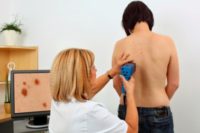Deadly skin cancer rates have doubled over last three decades

Melanoma rates doubled between 1982 and 2011 but comprehensive skin cancer prevention programs could prevent 20 percent of new cases between 2020 and 2030, according to this month’s Vital Signs report.
Treatment costs expected to triple
Skin cancer is the most common form of cancer in the U.S., and melanoma is the most deadly type of skin cancer. More than 90 percent of melanoma skin cancers are due to skin cell damage from ultraviolet (UV) radiation exposure. Melanoma rates increased from 11.2 per 100,000 in 1982 to 22.7 per 100,000 in 2011. The report notes that without additional community prevention efforts, melanoma will continue to increase over the next 15 years, with 112,000 new cases projected in 2030. The annual cost of treating new melanoma cases is projected to nearly triple from $457 million in 2011 to $1.6 billion in 2030.
This Vital Signs report shows that melanoma is responsible for more than 9,000 skin cancer deaths each year. In 2011, more than 65,000 melanoma skin cancers were diagnosed. By 2030, according to the report, effective community skin cancer prevention programs could prevent an estimated 230,000 melanoma skin cancers and save $2.7 billion dollars in treatment costs. Successful programs feature community efforts that combine education, mass media campaigns, and policy changes to increase skin protection for children and adults.
How to protect yourself
“Melanoma is the deadliest form of skin cancer, and it’s on the rise,” said CDC Director Tom Frieden, M.D., M.P.H. “Protect yourself from the sun by wearing a hat and clothes that cover your skin. Find some shade if you’re outside, especially in the middle of the day when the dangerous rays from the sun are most intense, and apply broad-spectrum sunscreen.”
Researchers reviewed data from CDC’s National Program of Cancer Registries and the National Cancer Institute’s Surveillance, Epidemiology and End Results Program (SEER) to help determine the increase in melanoma rates.
Most other cancers are declining
“The rate of people getting melanoma continues to increase every year compared to the rates of most other cancers, which are declining,” said Lisa Richardson, MD, MPH, Director of the Division of Cancer Prevention and Control. “If we take action now, we can prevent hundreds of thousands of new cases of skin cancers, including melanoma, and save billions of dollars in medical costs.”
This Vital Signs report highlights the recommendations for communities from the Community Guide for Preventive Services. Communities can increase shade on playgrounds, at public pools, and other public spaces, promote sun protection in recreational areas, encourage employers, childcare centers, schools, and colleges to educate about sun safety and skin protection, and restrict the availability and use of indoor tanning by minors. Everyone is encouraged to protect their skin with protective clothing, wide-brimmed hats, broad-spectrum SPF sunscreen, and seek shade outdoors.
How to get help
Through the Affordable Care Act, more Americans will qualify to get healthcare coverage that fits their needs and budget, including important preventive services. Behavioral counseling is now provided with no cost-sharing to counsel people aged 10–24 years with fair skin about limiting their exposure to UV radiation to reduce risk of skin cancer. Visit Healthcare.gov or call 1-800-318-2596 (TTY/TDD 1-855-889-4325) to learn more.
To learn about CDC’s efforts to prevent skin cancer, visit: www.cdc.gov/cancer/skin.
Looking for a reprint of this article?
From high-res PDFs to custom plaques, order your copy today!






